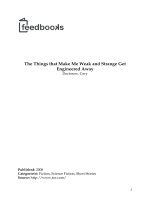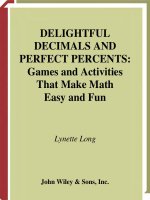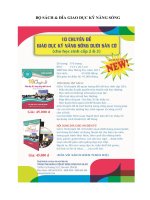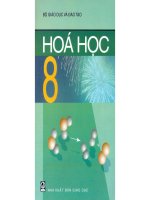Bộ sách Creative activities that make math science fun for kids Cool string art
Bạn đang xem bản rút gọn của tài liệu. Xem và tải ngay bản đầy đủ của tài liệu tại đây (8.31 MB, 34 trang )
-TO LIBRAR
Y
HOW
CHECKERB
OA
RD
COOL ART WITH MATH & SCIENCE
STRING ART
CREATIVE ACTIVITIES THAT MAKE MATH & SCIENCE
FUN FOR KIDS!
ANDERS HANSON AND ELISSA MANN
C O O L A R T W IT H MAT H & SCIEN CE
STRING ART
CREAT IVE A C TIVITIE S T H A T M A K E M A T H
FUN FOR KIDS!
ANDERS HANSON
&
SC I E N C E
AND ELISSA MANN
V I S IT U S AT W W W. A B D O P U B LI S H I N G.CO M
Published by ABDO Publishing Company, a division of ABDO, P.O. Box 398166, Minneapolis,
Minnesota 55439. Copyright © 2014 by Abdo Consulting Group, Inc. International copyrights
reserved in all countries. No part of this book may be reproduced in any form without written
permission from the publisher. Checkerboard Library™ is a trademark and logo of ABDO Publishing
Company.
Printed in the United States of America, North Mankato, Minnesota
062013
092013
Design and Production: Anders Hanson, Mighty Media, Inc.
Series Editor: Liz Salzmann
Photo Credits: Anders Hanson, Shutterstock
LIBRARY OF CONGRESS CATALOGING-IN-PUBLICATION DATA
Hanson, Anders, 1980Cool string art : creative activities that make math & science fun for kids! / Anders Hanson and Elissa
Mann.
pages cm. -- (Cool art with math & science)
Includes index.
ISBN 978-1-61783-824-8
1. Geometry--Juvenile literature. 2. Astronomy--Juvenile literature. 3. Mathematical recreations-Juvenile literature. 4. Scientific recreations--Juvenile literature. 5. String craft--Juvenile literature.
6. Creative activities and seat work--Juvenile literature. I. Mann, Elissa, 1990- II. Title.
QA445.5.H364 2013
516’.154--dc23
2013001895
C O NT E NT S
4
6
8
12
14
18
COOL STRING ART
LIN ES I N SPAC E
A PERFECT FIT
REGUL A R P OLYG ON S A N D C I R C LE S
P ROJE C T
1
STRING ART POLYGONS
WRI T I N G
LETTE R S A N D L I N ES
P ROJE C T
2
STRING ART LETTER
AS T R O N O M Y
THE OL D EST SC I EN C E
20
24
26
30
31
31
32
PROJECT
3
STRING ART CONSTELLATION
PLA NETS
TH E G R E AT E I G H T
PROJECT
4
STRING ART PLANETS
M A TH TERM S
GLOS S A RY
W EB S ITES
INDEX
STRING ART
LINES
IN SPACE
M
aking string art is a fun way to play with lines. This book will show
you how to make string art. You’ll learn cool stuff about geometry,
history, and astronomy too!
4
When strings overlap, they create a lot of
interesting shapes. Check them out as you’re
making the projects!
5
String art is math in real life.
People use string art to make
mathematical shapes!
A PERFE C T F I T
REGULAR POLYGONS AND CIRCLES
A
polygon is a shape with straight sides. In regular polygons, such as squares, the sides are
all the same length. The angles of a regular polygon are equal. Any regular polygon will
fit perfectly inside a circle. All of the vertices will lie on the circle.
VERTEX
SIDE
ANGLE
EQUILATERAL TRIANGLE
(3 SIDES, 3 VERTICES, 60-DEGREE ANGLES)
SQUARE
(4 SIDES, 4 VERTICES, 90-DEGREE ANGLES)
6
As the number of sides increases, the number of angles does too. The angles become wider.
The points get closer to each other. The polygon begins to look more and more like a circle!
REGULAR HEXAGON
(6 SIDES, 6 VERTICES, 120-DEGREE ANGLES)
REGULAR DODECAGON
(12 SIDES, 12 VERTICES, 150-DEGREE ANGLES)
7
8
PROJ E C T
1
STRING ART
POLYGONS
STUFF
Y O U´L L
NEED
đƫ COMPASS WITH
PENCIL
đƫ THUMBTACKS
đƫ CORKBOARD
đƫ STRING
đƫ SCISSORS
đƫ PAPER
TERMS
đƫ POLYGON
đƫ CIRCLE
đƫ INTERSECT
đƫ TRIANGLE
U
se a circle to create geometric string art
shapes. You can create many different
polygons. Try them all!
The photo on the left shows part of a complete
graph. Each point in the circle is connected to
every other point. How many polygons in the
photo can you name?
9
đƫ SQUARE
đƫ HEXAGON
đƫ DODECAGRAM
đƫ GEOMETRIC
3
MAKE THE
TEMPLATE
1 Use the compass to draw a large circle.
2 Set the compass to half of its
previous length. Place the
compass point anywhere on
the circle. Draw a half circle.
3
4
Put the compass point where the half
circle and the large circle intersect.
Draw another half circle. Repeat until
no more half circles can be drawn.
4 Cut out the large circle. Set it on the
corkboard. Insert a tack into each
point where a half circle intersects
with the large circle. Erase the pencil
lines. Number the tacks clockwise,
from 1 to 12.
THE TRIANGLE
5
5
10
Tie the string around tack 1.
Wrap the string around the
outside of tacks 5, 9, and 1.
6
THE SQUARE
6
Tie the string around tack 1. Wrap
the string around the outside
of tacks 4, 7, 10, and 1.
THE HEXAGON
7
Tie the string around tack 1. Wrap
the string around the outside of
tacks 3, 5, 7, 9, 11, and 1.
7
THE DODECAGRAM
8
Tie the string around tack 1. Wrap the
string around the outside of tacks 6, 11, 4,
9, 2, 7, 12, 5, 10, 3, 8, and 1.
THE COMPLETE GRAPH
9 A complete graph connects all 12
8
points together. Tie the string around
tack 1. Go in any order to connect
the tacks. Make sure each tack is
connected to all of the other tacks.
11
WRITIN G
LETTERS AND LINES
W
riting is a common use for lines on paper. Letters and words are just lines
bent into different shapes. Writing did not always look like it does today.
It changed over time.
The first writing was invented in Sumeria around 3200 B.C. The Sumerians
pressed the tips of reeds into clay tablets. Writing started to look more like it
does now in 900 B.C. That is when the Phoenician alphabet was widely used.
PHOENICIAN
LETTERS
GREEK
LETTERS
LATIN
LETTERS
12
Around 800 B.C. the Greeks developed their alphabet. They borrowed a lot from the
Phoenicians. The Greek language still uses the Greek alphabet. The Romans created the
Latin alphabet in 600 B.C. They borrowed a lot from the Greeks. Today, most Western
languages, including English, use the Latin alphabet.
Compare the shapes from the Phoenician alphabet, the Greek alphabet, and the Latin
alphabet. Find the similarities!
13
14
PROJ E C T
2
STRING ART
LETTER
STUFF
Y O U´L L
NEED
đƫ CORKBOARD
đƫ WAXED PAPER
đƫ PAPER
đƫ SCISSORS
đƫ TAPE
đƫ COLORED
STRING
đƫ PUSH PINS
đƫ GLUE
đƫ FOAM BRUSH
TERMS
đƫ ALPHABET
đƫ LETTER
T
he Latin alphabet has its roots in the Phoenician
alphabet. The letters changed over time. Many
letters still look similar.
Today, the most frequently used letter in the English
language is E. The Latin E looks like a letter in the
Phoenician alphabet. Can you figure out which one?
Try making your own letter in this project!
15
1
HOW TO MAKE IT
1
Cover the corkboard with a
sheet of waxed paper.
2 Draw the letter you are using on a
piece of paper. Or you can print the
letter out from a computer. Make
the letter big enough to fill most of
the corkboard. Cut out the letter.
3
3
Place the letter cutout on the
waxed paper. Tape it in place.
4 Insert pushpins around the edges
of the letter. Space the pins equally.
Don’t put them through the letter.
5 Remove the letter cutout.
4
16
6
6
Tie one end of string around a pin.
Wrap the string a couple of times
around the nearby pushpins. Then
begin wrapping around new pins.
Cross the string back and forth
inside the letter. Keep wrapping
until the entire letter shape is filled.
9
7 Tie the end of the string to a
pin. Cut off the excess.
8 Use a foam brush to apply glue
to the string. Let the glue dry.
9
Carefully remove the pins.
Flip the letter over.
10 Apply a coat of glue to the back
of the letter. Let the glue dry.
10
17
A STR O N O M Y
THE OLDEST SCIENCE
A
stronomy is the study of stars, planets, and other objects in space. It is the oldest
science. Throughout history, astronomers used stars to learn about the world.
Astronomers have
grouped some stars
into constellations. The
first constellations were
identified nearly 2,000
years ago by Claudius
Ptolemy. He was a Greek
astronomer.
There are now
88 constellations
recognized by
the International
Astronomical Union.
Constellations were used to navigate. They were also used
to form calendars and keep track of time.
18
Many constellations have memorable geometric shapes and lines.
One of the most well-known constellations is Ursa Major.
Ursa Major
means Big Bear.
The seven brightest stars of
Ursa Major have many names. In
the United States and Canada
they are called the Big Dipper.
In England and Ireland they are
called the Plough.
19
20
P ROJE C T
3
B
STRING ART
CONSTELLATION
STUFF
Y O U´L L
NEED
đƫ CORKBOARD
đƫ BLACK ACRYLIC
PAINT
đƫ FOAM BRUSH
đƫ GLOW-IN-THEDARK STICKERS
đƫ THUMB TACKS
đƫ SCISSORS
đƫ STRING
đƫ PAPER
đƫ PEN OR MARKER
TERMS
đƫ STAR
đƫ CONSTELLATION
ecome an astronomer in your own room! Take
the stars inside with you.
Use glow-in-the-dark stickers to make your favorite
constellations. Display them on your wall or ceiling.
At night, you’ll be stargazing inside!
21
1
HOW TO MAKE IT
1
Paint the corkboard black.
Let the paint dry.
2 Pick a constellation to make.
Choose a constellation on page
20, or look one up online.
3
3
Count out the same number of
tacks as stars in the constellation.
Put a glow-in-the-dark sticker
on the top of each tack.
4 Use the tacks to create the
constellation on the corkboard.
4
22
5
5
Tie the string around a tack. Wrap
the string around every tack in the
constellation. Pull the string tight
to form lines connecting the stars.
Go around each tack only once.
6
Tie the string to the last tack.
Cut off any excess string.
7
6
Write the name of the
constellation on a piece of paper.
Glue it to the corkboard.
8 Have an adult help hang your
constellation on a wall or ceiling.
Turn out the lights. Watch it glow!
7
23









